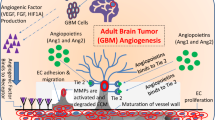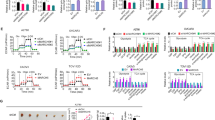Abstract
Glioblastoma is the most aggressive primary brain tumor with hypoxia-associated morphologic features including pseudopalisading necrosis and endothelial hyperplasia. It has been known that hypoxia can activate signal transducer and activator of transcription 3 (Stat3) and subsequently induce angiogenesis. However, the molecular mechanism underlying hypoxia-induced Stat3 activation has not been defined. In this study, we explored the possible implication of reactive oxygen species (ROS) in hypoxia-driven Stat3 activation in human glioblastoma. We found that hypoxic stress increased ROS production as well as Stat3 activation and that ROS inhibitors (diphenyleneiodonium, rotenone and myxothiazol) and an antioxidant (N-acetyl-l-cysteine) blocked Stat3 activation under hypoxic conditions. To determine a major route of ROS production, we tested whether nicotinamide adenine dinucleotide phosphate oxidase 4 (Nox4) is involved in hypoxia-induced ROS production. Nox4 expression was found to be increased at both mRNA and protein levels in hypoxic glioblastoma cells. In addition, siRNA-mediated knockdown of Nox4 expression abolished hypoxia induced Stat3 activation and vascular endothelial growth factor expression, which is associated with tumor cells’ ability to trigger tube formation of endothelial cells in vitro. Our findings indicate that elevated ROS production plays a crucial role for Stat3 activation and angiogenesis in hypoxic glioblastoma cells.




Similar content being viewed by others
References
Weissenberger J, Loeffler S, Kappeler A, Kopf M, Lukes A, Afanasieva TA, Aguzzi A, Weis J (2004) IL-6 is required for glioma development in a mouse model. Oncogene 23:3308–3316. doi:10.1038/sj.onc.1207455
Kang SH, Yu MO, Park KJ, Chi SG, Park DH, Chung YG (2010) Activated STAT3 regulates hypoxia-induced angiogenesis and cell migration in human glioblastoma. Neurosurgery 67:1386–1395; discussion 1395. doi:10.1227/NEU.0b013e3181f1c0cd
Turkson J, Jove R (2000) STAT proteins: novel molecular targets for cancer drug discovery. Oncogene 19:6613–6626. doi:10.1038/sj.onc.1204086
Miscia S, Marchisio M, Grilli A, Di Valerio V, Centurione L, Sabatino G, Garaci F, Zauli G, Bonvini E, Di Baldassarre A (2002) Tumor necrosis factor alpha (TNF-alpha) activates Jak1/Stat3–Stat5B signaling through TNFR-1 in human B cells. Cell Growth Differ Mol Biol J Am Assoc Cancer Res 13:13–18
Heinrich PC, Behrmann I, Muller-Newen G, Schaper F, Graeve L (1998) Interleukin-6-type cytokine signalling through the gp130/Jak/STAT pathway. Biochem J 334(Pt 2):297–314
Tacchini L, Fusar-Poli D, Sironi M, Mantovani A, Bernelli-Zazzera A (2003) Activation of signal transducer and activator of transcription 3 in rat liver after heat shock and reperfusion stress. Int J Biochem Cell Biol 35:316–323
Darnell JE Jr, Kerr IM, Stark GR (1994) Jak-STAT pathways and transcriptional activation in response to IFNs and other extracellular signaling proteins. Science (New York NY) 264:1415–1421
Schaefer LK, Wang S, Schaefer TS (1999) c-Src activates the DNA binding and transcriptional activity of Stat3 molecules: serine 727 is not required for transcriptional activation under certain circumstances. Biochem Biophys Res Commun 266:481–487. doi:10.1006/bbrc.1999.1853
Bowman T, Garcia R, Turkson J, Jove R (2000) STATs in oncogenesis. Oncogene 19:2474–2488. doi:10.1038/sj.onc.1203527
Johnston PA, Grandis JR (2011) STAT3 signaling: anticancer strategies and challenges. Mol Interv 11:18–26. doi:10.1124/mi.11.1.4
Hoeben A, Landuyt B, Highley MS, Wildiers H, Van Oosterom AT, De Bruijn EA (2004) Vascular endothelial growth factor and angiogenesis. Pharmacol Rev 56:549–580. doi:10.1124/pr.56.4.3
Siveen KS, Sikka S, Surana R, Dai X, Zhang J, Kumar AP, Tan BK, Sethi G, Bishayee A (2014) Targeting the STAT3 signaling pathway in cancer: role of synthetic and natural inhibitors. Biochim Biophys Acta 1845:136–154. doi:10.1016/j.bbcan.2013.12.005
Xie TX, Wei D, Liu M, Gao AC, Ali-Osman F, Sawaya R, Huang S (2004) Stat3 activation regulates the expression of matrix metalloproteinase-2 and tumor invasion and metastasis. Oncogene 23:3550–3560. doi:10.1038/sj.onc.1207383
Jung JE, Lee HG, Cho IH, Chung DH, Yoon SH, Yang YM, Lee JW, Choi S, Park JW, Ye SK, Chung MH (2005) STAT3 is a potential modulator of HIF-1-mediated VEGF expression in human renal carcinoma cells. FASEB J Off Publ Feder Am Soc Exp Biol 19:1296–1298. doi:10.1096/fj.04-3099fje
Gray MJ, Zhang J, Ellis LM, Semenza GL, Evans DB, Watowich SS, Gallick GE (2005) HIF-1alpha, STAT3, CBP/p300 and Ref-1/APE are components of a transcriptional complex that regulates Src-dependent hypoxia-induced expression of VEGF in pancreatic and prostate carcinomas. Oncogene 24:3110–3120. doi:10.1038/sj.onc.1208513
Chen Z, Han ZC (2008) STAT3: a critical transcription activator in angiogenesis. Med Res Rev 28:185–200. doi:10.1002/med.20101
Hamanaka RB, Chandel NS (2010) Mitochondrial reactive oxygen species regulate cellular signaling and dictate biological outcomes. Trends Biochem Sci 35:505–513. doi:10.1016/j.tibs.2010.04.002
D’Autreaux B, Toledano MB (2007) ROS as signalling molecules: mechanisms that generate specificity in ROS homeostasis. Nat Rev Mol Cell Biol 8:813–824. doi:10.1038/nrm2256
Hsieh CH, Wu CP, Lee HT, Liang JA, Yu CY, Lin YJ (2012) NADPH oxidase subunit 4 mediates cycling hypoxia-promoted radiation resistance in glioblastoma multiforme. Free Radic Biol Med 53:649–658. doi:10.1016/j.freeradbiomed.2012.06.009
Guzy RD, Hoyos B, Robin E, Chen H, Liu L, Mansfield KD, Simon MC, Hammerling U, Schumacker PT (2005) Mitochondrial complex III is required for hypoxia-induced ROS production and cellular oxygen sensing. Cell Metab 1:401–408. doi:10.1016/j.cmet.2005.05.001
Diebold I, Petry A, Hess J, Gorlach A (2010) The NADPH oxidase subunit NOX4 is a new target gene of the hypoxia-inducible factor-1. Mol Biol Cell 21:2087–2096. doi:10.1091/mbc.E09-12-1003
Li S, Tabar SS, Malec V, Eul BG, Klepetko W, Weissmann N, Grimminger F, Seeger W, Rose F, Hanze J (2008) NOX4 regulates ROS levels under normoxic and hypoxic conditions, triggers proliferation, and inhibits apoptosis in pulmonary artery adventitial fibroblasts. Antioxid Redox Signal 10:1687–1698. doi:10.1089/ars.2008.2035
Lambeth JD (2004) NOX enzymes and the biology of reactive oxygen. Nat Rev Immunol 4:181–189. doi:10.1038/nri1312
Hsieh CH, Shyu WC, Chiang CY, Kuo JW, Shen WC, Liu RS (2011) NADPH oxidase subunit 4-mediated reactive oxygen species contribute to cycling hypoxia-promoted tumor progression in glioblastoma multiforme. PLoS One 6:e23945. doi:10.1371/journal.pone.0023945
Shono T, Yokoyama N, Uesaka T, Kuroda J, Takeya R, Yamasaki T, Amano T, Mizoguchi M, Suzuki SO, Niiro H, Miyamoto K, Akashi K, Iwaki T, Sumimoto H, Sasaki T (2008) Enhanced expression of NADPH oxidase Nox4 in human gliomas and its roles in cell proliferation and survival. Int J Cancer 123:787–792. doi:10.1002/ijc.23569
Harris AL (2002) Hypoxia—a key regulatory factor in tumour growth. Nat Rev Cancer 2:38–47. doi:10.1038/nrc704
Evans SM, Judy KD, Dunphy I, Jenkins WT, Hwang WT, Nelson PT, Lustig RA, Jenkins K, Magarelli DP, Hahn SM, Collins RA, Grady MS, Koch CJ (2004) Hypoxia is important in the biology and aggression of human glial brain tumors. Clin Cancer Res Off J Am Assoc Cancer Res 10:8177–8184. doi:10.1158/1078-0432.ccr-04-1081
Keunen O, Johansson M, Oudin A, Sanzey M, Rahim SA, Fack F, Thorsen F, Taxt T, Bartos M, Jirik R, Miletic H, Wang J, Stieber D, Stuhr L, Moen I, Rygh CB, Bjerkvig R, Niclou SP (2011) Anti-VEGF treatment reduces blood supply and increases tumor cell invasion in glioblastoma. Proc Natl Acad Sci USA 108:3749–3754. doi:10.1073/pnas.1014480108
Dreyfuss JM, Johnson MD, Park PJ (2009) Meta-analysis of glioblastoma multiforme versus anaplastic astrocytoma identifies robust gene markers. Mol Cancer 8:71. doi:10.1186/1476-4598-8-71
Raza SM, Fuller GN, Rhee CH, Huang S, Hess K, Zhang W, Sawaya R (2004) Identification of necrosis-associated genes in glioblastoma by cDNA microarray analysis. Clin Cancer Res Off J Am Assoc Cancer Res 10:212–221
Louis DN, Ohgaki H, Wiestler OD, Cavenee WK, Burger PC, Jouvet A, Scheithauer BW, Kleihues P (2007) The 2007 WHO classification of tumours of the central nervous system. Acta Neuropathol 114:97–109. doi:10.1007/s00401-007-0243-4
Zagzag D, Esencay M, Mendez O, Yee H, Smirnova I, Huang Y, Chiriboga L, Lukyanov E, Liu M, Newcomb EW (2008) Hypoxia- and vascular endothelial growth factor-induced stromal cell-derived factor-1alpha/CXCR4 expression in glioblastomas: one plausible explanation of Scherer’s structures. Am J Pathol 173:545–560. doi:10.2353/ajpath.2008.071197
Harada H, Kizaka-Kondoh S, Li G, Itasaka S, Shibuya K, Inoue M, Hiraoka M (2007) Significance of HIF-1-active cells in angiogenesis and radioresistance. Oncogene 26:7508–7516. doi:10.1038/sj.onc.1210556
Li L, Lin X, Shoemaker AR, Albert DH, Fesik SW, Shen Y (2006) Hypoxia-inducible factor-1 inhibition in combination with temozolomide treatment exhibits robust antitumor efficacy in vivo. Clin Cancer Res Off J Am Assoc Cancer Res 12:4747–4754. doi:10.1158/1078-0432.ccr-05-2842
Mizoguchi M, Betensky RA, Batchelor TT, Bernay DC, Louis DN, Nutt CL (2006) Activation of STAT3, MAPK, and AKT in malignant astrocytic gliomas: correlation with EGFR status, tumor grade, and survival. J Neuropathol Exp Neurol 65:1181–1188. doi:10.1097/01.jnen.0000248549.14962.b2
Carro MS, Lim WK, Alvarez MJ, Bollo RJ, Zhao X, Snyder EY, Sulman EP, Anne SL, Doetsch F, Colman H, Lasorella A, Aldape K, Califano A, Iavarone A (2010) The transcriptional network for mesenchymal transformation of brain tumours. Nature 463:318–325. doi:10.1038/nature08712
Simon AR, Rai U, Fanburg BL, Cochran BH (1998) Activation of the JAK-STAT pathway by reactive oxygen species. Am J Physiol 275:C1640–C1652
Zepeda AB, Pessoa A Jr, Castillo RL, Figueroa CA, Pulgar VM, Farias JG (2013) Cellular and molecular mechanisms in the hypoxic tissue: role of HIF-1 and ROS. Cell Biochem Funct 31:451–459. doi:10.1002/cbf.2985
Edderkaoui M, Nitsche C, Zheng L, Pandol SJ, Gukovsky I, Gukovskaya AS (2011) NADPH oxidase activation in pancreatic cancer cells is mediated through Akt-dependent up-regulation of p22phox. J Biol Chem 286:7779–7787. doi:10.1074/jbc.M110.200063
Lee JK, Edderkaoui M, Truong P, Ohno I, Jang KT, Berti A, Pandol SJ, Gukovskaya AS (2007) NADPH oxidase promotes pancreatic cancer cell survival via inhibiting JAK2 dephosphorylation by tyrosine phosphatases. Gastroenterology 133:1637–1648. doi:10.1053/j.gastro.2007.08.022
Souza V, Escobar Mdel C, Bucio L, Hernandez E, Gomez-Quiroz LE, Gutierrez Ruiz MC (2009) NADPH oxidase and ERK1/2 are involved in cadmium induced-STAT3 activation in HepG2 cells. Toxicol Lett 187:180–186. doi:10.1016/j.toxlet.2009.02.021
Bulua AC, Simon A, Maddipati R, Pelletier M, Park H, Kim KY, Sack MN, Kastner DL, Siegel RM (2011) Mitochondrial reactive oxygen species promote production of proinflammatory cytokines and are elevated in TNFR1-associated periodic syndrome (TRAPS). J Exp Med 208:519–533. doi:10.1084/jem.20102049
Acknowledgments
This research was supported by Basic Science Research Program through the National Research Foundation of Korea (NRF) funded by the Ministry of Education, Science and Technology (NRF-2012R1A1A2001528).
Author information
Authors and Affiliations
Corresponding authors
Ethics declarations
Conflict of interests
None.
Electronic supplementary material
Below is the link to the electronic supplementary material.
Fig. S1 An increase of various intracellular ROS production by hypoxic stress. a U87 cells were incubated under hypoxic condition for 6 and 24 h and stained with 5 μM DCFDA, 30 μM Mitosox and 10 μM DHE for 30 min under normoxic condition. ROS levels were measured by flow cytometry
Fig. S2 Knockdown of siNox4 in glioblastoma and its effect on Stat3 activation and related ROS production. a U87 cells were transfected with vehicle, siControl, siNox4-1 or siNox4-2 and incubated for 96 h. Whole-cell lysates were extracted and subjected to immunoblot. b Vehicle, siControl or siNox4-1-transfected U87 cells were collected at the indicated times after transfection and Nox4 protein was examined by immunoblot. c At 48 h after siControl or siNox4-1 transfection, U87 cells were exposed to hypoxic stress for 6 h. Phospho-Stat3 expression was analyzed by immunofluorescence stain. d siNox4-1 transfected U87 cells were incubated under normoxic or hypoxic condition for 6 h and stained with 10 μM DHE for 30 min. Cytoplasmic superoxide production was measured by flow cytometry
Rights and permissions
About this article
Cite this article
Yu, M.O., Park, KJ., Park, DH. et al. Reactive oxygen species production has a critical role in hypoxia-induced Stat3 activation and angiogenesis in human glioblastoma. J Neurooncol 125, 55–63 (2015). https://doi.org/10.1007/s11060-015-1889-8
Received:
Accepted:
Published:
Issue Date:
DOI: https://doi.org/10.1007/s11060-015-1889-8




